
New Poinsettia Standouts for 2016
With more than 150 cultivars, the 2015 North American Poinsettia trials were the largest ever. The trials included several new introductions for 2016 that are potentially important for just about every grower. New vigorous reds with stem strength have been released that work well for the increasing number of growers who are using shorter schedules to squeeze poinsettias in after fall mums. Among novelties, there is a chartreuse poinsettia and nice additions to the Autumn Leaves and Luv U Pink groups. Distinctly improved pink cultivars are also coming out in 2016. Several new reds and colors have also been released that offer improved performance and useful characteristics for both larger and smaller growers.
The number and caliber of new introductions makes it very challenging for growers to sort through them and determine which ones might fit into their production styles and markets. We hope these trials and reports will allow growers to be more efficient in finding the new cultivars that will work best for them.
Poinsettia performance can vary considerably with different production environments. The strength of the North American Poinsettia Trials is they provide independent critiques of the new cultivars at three locations in North America representing very different climates: Florida, North Carolina and Ontario, Canada. The four major poinsettia breeder companies (Ball/ Selecta, Beekenkamp, Dümmen Orange and Syngenta) are working hard to provide improved genetics in the poinsettia market. We appreciate their support to make the trials possible.
RED
‘Aries Red’ (Beekenkamp). These plants have rounded medium-sized bracts with a bright, slightly orange-red color. Bracts are displayed flat with six to nine large showy cyathia within an open inflorescence center. Branching was good and uniform resulting in a well-shaped plant. Stem strength was good, and plants flowered midseason. Plants were vigorous in North Carolina and average vigor in the Ontario trial. Plants responded well to PGR applications and would be suitable to a variety of pot sizes.
‘Blissful Red’ (Beekenkamp). The medium-sized bracts are held flat and, along with the uniform stem elongation, puts the bracts in a single plane on top of the plant canopy. Bract color is a vibrant deep red, and cyathia are large and colorful. Plants flowered mid to late season. In North Carolina and Ontario, plants were medium vigor with very good branching. Plants were upright with large caliper stems. Florida plants were larger and greater amounts of PGRs were needed. In Florida also, the laterals started growing rapidly, even before pinching, and the stems were a little thin at the base; earlier PGR applications would have helped this. ‘Blissful Red’ has the potential to be a useful cultivar for 6-inch and larger pot sizes.
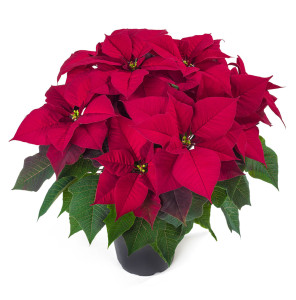
‘Centauri Red’ (Beekenkamp). These plants have bright rosy-red, heart-shaped bracts. Bract centers are large with large, colorful cyathia and the inflorescences are open. The first transition bracts are a deep red that is almost burgundy. Branching is very good. However, in Florida’s heat, the stems were thin and elongated, resulting in weak plants. Additional PGR was needed earlier on the crop. Stem strength was better in North Carolina. Plants flowered mid to late season. ‘Centauri Red’ plants are vigorous and probably would be best used in 6½ -inch and larger containers.
‘Christmas Star’ (Ball/Selecta). In Europe, poinsettias are often called Christmas stars and Cycocel sprays may be used to produce an appearance of compact red stars on a background of dark green leaves. ‘Christmas Star’ has thick stems and an upright habit. While it exhibited only slightly above average vigor in Ontario, plants were highly vigorous in Florida and may need more than average PGR. In Florida, finish timing was late, while in Ontario timing was midseason. This cultivar has the combination of vigor and strength needed to be an outstanding plant in larger sizes. The larger plants also will allow the distinctive star appearance to stand out.

‘Ferrara’ (Dümmen Orange). The name of this cultivar is supposed to create an image of a red sports car. ‘Ferrara’ is a fast growing, vigorous, red cultivar that is being positioned for growers who use a short schedule. The general appearance of ‘Ferrara’ is somewhat similar to ‘Advent Red’ and ‘Tikal Red’. Bract color is a bright, slightly orange red. Centers are large with numerous cyathia that hold well. Initially bracts are smooth and medium to large in size. As plants mature, bracts curve downward a bit at the edges, reminiscent of ‘Advent Red’. The plants have good branching, very strong stems and an upright habit. Shoot elongation is varied resulting in the bracts being staggered at the top of the plant rather than a uniform plant shape. In the Florida heat, the plants did not stretch and were easy to manage. Plants flowered early to midseason. ‘Ferrara’ should be useful in a wide range of formats.
‘Freedom Red 2015’ (Dümmen Orange). ‘Freedom Red’ was the standard cultivar in North America during the 1990s and is still used by many. ‘Freedom Red 2015’ is a new selection that is meant to reduce the amount of variation seen in ‘Freedom Red’ and reduce late season stretch. The plants still have the standard Freedom appearance and growth habit. Plants flowered midseason. This selection will replace the previous ‘Freedom Red’, so growers who order ‘Freedom Red’ for 2016 will receive this new selection.
‘Leona Red’ (Beekenkamp). This vigorous cultivar with strong upright stems has smooth medium red bracts that point upward at the tip. Plants flowered late midseason. This cultivar performed differently in the northern and southern trials. In North Carolina, the inflorescences were stretched out with long internodes between the bracts. In addition, cyathia clusters were large with long petioles on the bracts, producing large open inflorescences. Despite its vigor, plants responded well to PGRs. In Ontario, however, the open inflorescence and stem stretching was not observed, and plant appearance was very good. ‘Leona Red’ has strong potential in northern climates and could be used in a variety of sizes. This cultivar was not in the Florida trial and probably needs further evaluation in warm climates.
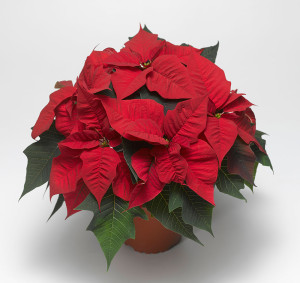
‘Magma Red’ (Syngenta). The bracts are bright red with distinctive green, red and yellow color in the cyathia. Bracts are held flat. The plants have thick stems and a good upright habit. There was a considerable number of small secondary shoots inside the plant. Plants are medium to high vigor. Plants tended to open up some in the Florida heat, but performed well in North Carolina and Ontario. Lateral elongation after the pinch was rapid, and early PGR sprays may be needed. Plants flowered late midseason in Ontario, but late in North Carolina and Florida. ‘Magma Red’ has the vigor to produce big plants and will be useful in larger plant sizes. In smaller containers, it will be useful where short schedules are used.
COLORS
‘Christmas Glory White’ and ‘Christmas Glory Pink’ (Ball/ Selecta). These are two new colors that generally match the appearance and growth habit of ‘Christmas Glory Red’. All three are low vigor, and this series is less vigorous than the Christmas Beauty series.
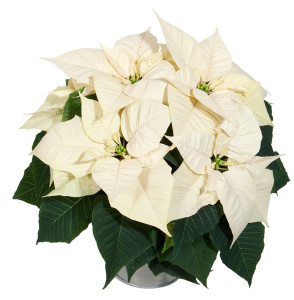
In North Carolina, the pink and white cultivars started coloring later than the red, but all three colors finished close together in both North Carolina and Ontario. In Florida, the pink cultivar finished considerably later and plant shape was less uniform compared to the red and white cultivars. Like ‘Christmas Glory Red’, the heartshaped bracts on these two colors are large and lie flat on top of the plant. ‘Christmas Glory White’ is a creamy white and might be an option for growers in warm climates who do not care for the lime white of ‘Christmas Beauty North Pole’. ‘Christmas Glory Pink’ is brighter than ‘Christmas Beauty Pink’, but has the classic grayish cast to older bracts and is not as bright as ‘Christmas Lights’. These two cultivars fit best in a program with ‘Christmas Glory Red’ in smaller sizes with less PGR use.
‘Christmas Joy White’ and ‘Christmas Joy Pink’ (Ball/Selecta). These two new colors are a good fit with ‘Christmas Joy Red’, and plants across the series have a uniform habit and shape. In North Carolina, the pink and white cultivars started coloring later than the red, but all three cultivars flowered at the same time. The series is slightly more vigorous and about a week earlier than the Christmas Beauty series. In Ontario, the series would be considered early midseason. Plant habit and strength varied in the trials. In Ontario, the plants were more upright and strength was similar to the Christmas Beauty series. However, in Florida, plants in the Christmas Joy series were not quite as strong compared to the Christmas Beauty series. This series of colors is very flexible in how they can be used. This may become one of the better series for use in mixed-color containers.

‘Christmas Lights’ (Ball/Selecta). This cultivar has distinctive large, bright pink bracts that are a better color than most pink cultivars and is a more true pink compared to ‘Christmas Beauty Pink’. Plants have medium to high vigor with strong stems and an upright shape. In Florida, the plants looked very good, but finish timing was late and there was noticeable reduction in bract size from PGRs. Flowering was late in North Carolina and late November in Ontario. ‘Christmas Lights’ has a plant habit that could be used in all pot sizes and the distinctive color would justify it being used as a stand-alone pink. For use in early markets, backcloth would be needed.
‘Solar Pink’ (Beekenkamp). ‘Solar Pink’ has large, medium pink bracts with deeper pink veins but with very little of the grayish cast on the older bracts. Color of the secondary bracts is a darker richer pink, but they are not
tight around the cyathia creating open clusters. Branching, branch strength and plant habit were excellent in Ontario and good in North Carolina and Florida.
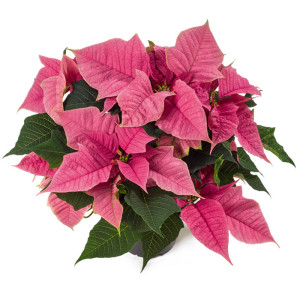
‘Solar Pink’ showed first color a little later than ‘Solar Red’, but was otherwise well matched. Plants were medium vigor and midseason. Like ‘Solar Red’ in Florida, ‘Solar Pink’ is a little more vigorous, requiring more PGR but still produces strong plants. This is a nice pink that could be used in all pot sizes.
‘Venus Hot Pink’ (Syngenta). This cultivar has a distinctive darkhot pink color with no grayish pink cast on the older bracts. Transition bracts were minimal, presenting a clean pink canopy. In low light indoors the dark pink appears closer to red. ‘Venus Hot Pink’ is a mutation from ‘Mars Late Red’ (previously named ‘Mars Red’) and has the general habit and appearance of ‘Mars Late Red’.
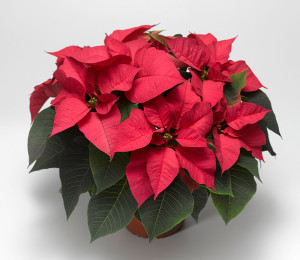
‘Venus Hot Pink’ is later flowering than ‘Mars Pink’ and ‘Early Mars Red’. The plants are very uniform and upright. The smaller than average bracts are held in a flat plane at the top of the canopy. The plants have high vigor and early PGR should be used. Plants flowered mid to late season. ‘Venus Hot Pink’ may heat delay in hot climates but does retain good stem strength. With the upright and uniform habit, ‘Venus Hot Pink’ would be useful in production at close spacing but also will produce attractive larger plants.
NOVELTY
‘Autumn Leaves 2016’ and ‘Gold Rush’ (Dümmen Orange). These are the two new cultivars in the Autumn Leaves category. The original ‘Autumn Leaves’ selection that growers evaluated for the past couple of years has been replaced by ‘Autumn Leaves 2016’, which has the same general growth habit and appearance. The difference is that ‘Autumn Leaves 2016’ has slightly more light pink flecking in the bracts. While ‘Gold Rush’ is quite similar to ‘Autumn Leaves 2016’ in habit and appearance, ‘Gold Rush’ is even less vigorous. ‘Gold Rush’ is also less pinkish with a stronger gold or yellow cast. Temperature has a strong effect on bract coloration of these cultivars. At high temperatures, the pink and the yellow casts are muted, and the colors are more intense at cooler temperatures. Low temperatures can bring out more green in the transition bracts. These cultivars have small centers with unremarkable cyathia. Both cultivars are very low vigor and finish early to midseason. Thus, it is important to ensure the plants have enough time from pinch to the start of short days to produce the size desired. This is especially important in cooler regions. In high temperature production, the stems can stretch and weaken, so small amounts of PGR are needed to create a stronger plant. Florida studies indicate they do not heat delay. They have good resistance to Botrytis and excellent postharvest durability. These cultivars are most useful in 6½-inch and smaller containers. The early finish makes them useful for fall decorations and other markets where a red poinsettia is not desired.
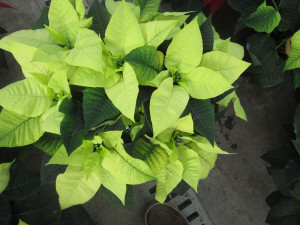
‘Envy’ (Dümmen Orange). Think “green with envy”. Yes, the bract color is light green or chartreuse. The bracts are medium in size with wavy margins and are held slightly up around tight centers. Stems are average in thickness and are generally upright; however, some plants with horizontal branches have been seen. Branching is average with some plants not branching well. Plants are medium vigor, but in the heat of Florida there was some stretching that was controlled with late PGR applications. In North Carolina and Ontario flowering was generally late, but it does respond well to use of backcloth for earlier finish. This cultivar has looked good in both warm and cool growing conditions. Based on consumer responses, Envy may not be as popular as novelties such as Ice Crystal or Ice Punch. But, it will be useful for growers producing differentiated products.
‘Luv U Hot Pink’, ‘Luv U Hot Splash’ and ‘Luv U Soft Pink’ (Dümmen Orange). These are three news cultivars in the Lov U Pink group, which creates a new product in the traditional poinsettia market. ‘Luv U Hot Pink’ has a deeper pink color and a pronounced whitish bract margin. ‘Luv U Hot Splash’ has a similar color as ‘Luv U Pink’, but has light-colored streaks through the bracts. ‘Luv U Soft Pink’ has deeper pink veins against a much lighter background color that is almost white and young bracts are a darker salmon pink. The growth habit and plant appearance of ‘Luv U Hot Pink’ and ‘Luv U Soft Pink’ are very similar to ‘Luv U Pink’. However, ‘Luv U Hot Splash’ is less vigorous than the other three (do not let that fool you — it still needs PGRs to control size.) Compared to poinsettias, the Luv U Pink cultivars have smaller leaves and smaller but many more bracts. The cyathia abort early, but that does not affect consumer demand as the plants continue producing bracts. Plants are generally well colored enough to be marketable early to midseason. These cultivars often split and are not recommended for non-pinched use. If cuttings are splitting early before the pinch, pinch below the split. The plants are vigorous and need more PGR for size control, especially in warm climates, compared to most poinsettia cultivars. Plants are very strong and upright, but shoot elongation is variable producing a non-uniform plant canopy. These cultivars can be used as pinched plants in all of the common sizes from 4 to 10 inches with proper PGR use.


 Video Library
Video Library 




















